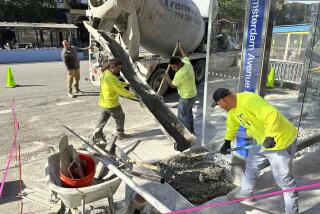Housing Permits and Starts Drop
- Share via
A sharp drop in U.S. housing starts and permits for new building in October pointed to some cooling in the red-hot real estate market, but the industrial sector picked up steam, government reports showed Thursday.
A third report found factory activity in the mid-Atlantic states slipped a bit more than expected in November as new orders declined, but employment improved.
The Commerce Department said housing starts fell 5.6% to a 2.014-million-unit annual rate, while permits for future groundbreaking fell 6.7% -- the biggest decline in six years.
It was the latest in a series of reports hinting that an anticipated slowdown in the five-year U.S. housing boom might have arrived.
“Gulf Coast rebuilding will help limit the softening, but the cyclical turn in housing is here,” said Ian Shepherdson, chief U.S. economist at High Frequency Economics.
With rising mortgage rates beginning to bite, economists had expected some slowing in housing figures, but they noted the overall level of housing starts is not weak by historical standards.
“In reality, starts have held steady above 2 million for the seventh straight month, and are quite strong in the face of rising interest rates and falling affordability,” said Wachovia economist Gina Martin.
Economists are watching housing closely because an expected cooling could crimp consumer spending and slow overall economic growth.
A separate report from the Federal Reserve showed a 0.9% bounce in industrial output from U.S. factories, mines and utilities in October.
It was the fastest rate since May 2004 as business recovered from hurricanes and a nearly monthlong aircraft workers’ strike was settled.
“The rebound in manufacturing output was stronger than generally thought. A lot of it is concentrated in aircraft,” said Kevin Logan, senior economist at Dresdner Kleinwort Wasserstein, noting the end of a strike at Boeing Co. contributed to a 37% surge in one subcategory.
The more recent report from the Philadelphia Fed showed regional output softened in November, with the business activity index falling to 11.5 in November from 17.3 in October.
But economists emphasized that these growth levels were respectable and noted the index tended to be volatile.
“The details of this report suggest less of a slowing in manufacturing growth than the headline index. Growth in manufacturing remains relatively robust,” said Bear Stearns chief economist John Ryding.
None of the reports Thursday was considered soft enough to dissuade the Federal Reserve from further interest rate hikes in its bid to keep a lid on inflation pressures.
Another economic release Thursday showed the number of U.S. workers filing for initial jobless claims fell sharply last week, hitting the lowest level since April and fully recovering from the effect of the recent hurricanes.
First-time claims for state unemployment insurance benefits dropped 25,000 to 303,000 last week, the Labor Department said, below expectations, and suggesting the next payroll employment report could top 200,000.
More to Read
Inside the business of entertainment
The Wide Shot brings you news, analysis and insights on everything from streaming wars to production — and what it all means for the future.
You may occasionally receive promotional content from the Los Angeles Times.










